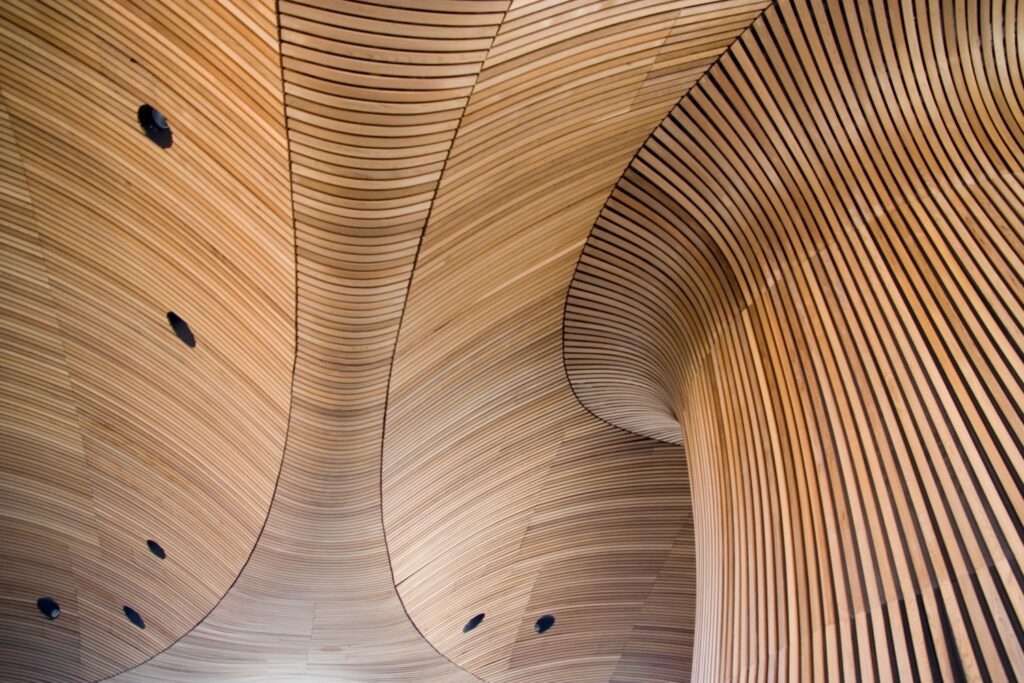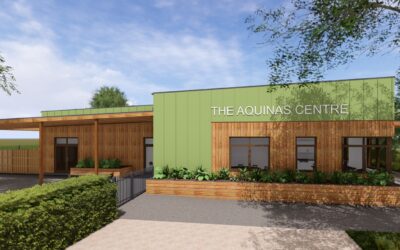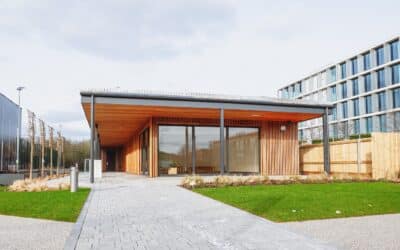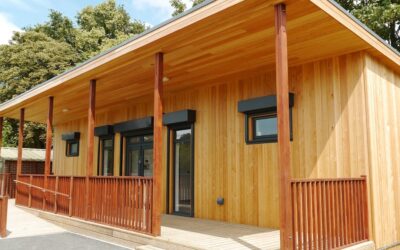TG Escapes Blog
BREEAM: Our Expert Team Weighs in
Across the UK and more than 100 other countries, BREEAM is the most famous framework for achieving environmentally friendly buildings at construction. Our team has seen the positives and negatives of BREEAM firsthand, alongside the crucial factors a client needs to consider if they want to achieve a high BREEAM score for a new building.
What is BREEAM?
BREEAM (Building Research Establishment Environmental Assessment Method) is a globally recognised framework for assessing the sustainability of buildings. Originating in the UK in 1990, it evaluates projects across categories like energy use, health and wellbeing, materials, waste, and transport. Buildings are scored on a points system, with the following ratings:
- Unclassified (<30)
- Pass (≥30%)
- Good (≥45%)
- Very Good (≥55%)
- Excellent (≥70%)
- Outstanding (≥85%)
BREEAM ratings are earned by achieving credits given across a range of categories (for example, within the energy category projects can achieve 3 credits for a low-carbon design, 1 for external lighting, and 12 for the reduction of energy use and carbon emissions). Licensed third-party assessors carry out the assessments for BREEAM, and subsequently undergo a Quality Audit from BRE Global Ltd. As of 2024, there are 2.33 million BREEAM-registered buildings across 102 countries, with one site describing it as “the world’s foremost environmental assessment method and rating system for buildings”.
As with any framework of this size, feelings around BREEAM are mixed in the construction industry. We spoke to Chris Leese, our technical director, Ryan Turner, our commercial manager, and Dan McAleer, our sales director, to get their thoughts.

The Bosco Verticale (“Vertical Forest”) skyscraper in Milan achieved a BREEAM score of 90%
What TG Escapes likes about BREEAM
As firm believers in sustainability, we recognise how crucial frameworks like BREEAM can be in forcing better practices across the industry. BREEAM requires concerted engagement from the first stages of preparation all the way through to aftercare to achieve the highest scores.
A clear positive of BREEAM is that it encourages projects to do much more detailed design work and to use premium components. When clients are committed to achieving high BREEAM scores, they can be convinced to invest in more environmentally friendly building elements.
“A good example would be for air source heat pump systems, where you would use a low refrigerant option to gain the most BREEAM credits. This is likely to be more expensive than a standard SOS heat pump system ” – Chris Leese
BREEAM also requires future-proofing to be considered in the design process.
“It forces you to consider not just the current thermal comfort in your design, but also what’s referred to as the future climate data. So for example, taking into account climate change, we’d have to answer how a building would feel and operate from an energy and a thermal comfort standpoint in 20 years. This could involve planning for replacement air source heat pumps that can meet higher cooling demand across the buildings, or replacement glazing with higher G values to prevent solar gain.” – Chris Leese
BREEAM’s emphasis on user training and operational efficiency is also a clear positive, with credits available for seasonal commissioning and comprehensive end-user manuals. This ensures that clients can make the most of the energy-saving potential in their buildings over time.
Our team was also enthusiastic about the emphasis on waste reduction, which is a particular area of focus for TG Escapes, and one of the elements of the BREEAM framework that corresponds best with modular construction.
What our team would change about BREEAM
One of the biggest challenges we face with BREEAM, which we’ll discuss in more detail later, is how crucial it is to plan around it from the very beginning, with several key credits missed when BREEAM is requested during the design phase. Beyond these difficulties, there are a few aspects of the BREEAM rating system that our team took issue with:
- To Chris, earning credits was difficult in smaller or bespoke buildings where meeting BREEAM criteria, such as separating incoming and extract ventilation 10 metres apart, was simply impossible on a small scheme.
- Clients have had to invest in additional elements to achieve a mandatory rating too late in the process adding pressure to budgets and timeframes.
- Chris echoed this, talking about how the system can push sites to add unnecessary transport links. For projects on university campuses, where additional transport is not needed, vital BREEAM credits can be lost. In some cases, universities move new buildings off-campus to set up new transport options and achieve a higher score. A 2019 study into BREEAM also noted in its review of literature that a common criticism was “BREEAM does not allow for adequate consideration of the variation in needs or opportunities in different geographical locations.”
- Ryan felt BREEAM could be “Onerous and quite expensive” for clients when there were other ways to achieve a sustainable, eco-friendly building.
Overall, a central issue for those looking to achieve high BREEAM scores is that the credit system doesn’t always consider context, and when projects stipulate that the highest scores must be achieved, this could potentially lead to unwise decisions being made.

Interior of the “Neuadd” in the Welsh Assembly Building, which achieved a BREEAM score of Excellent
Alternatives to BREEAM
There are a range of other frameworks for sustainable construction, with Chris singling out Passivhaus as a personal choice
“While BREEAM is a holistic approach, Passivhaus is much more focused on the building itself. So it almost takes the opposite view of going ‘I don’t care where you’re putting this or what your views are’ by focusing on the building’s physics to make the most energy-efficient building available.” – Chris Leese
You can find out more about the Passivhaus scheme through their website.
How we can achieve high BREEAM ratings with modular construction
TG Escapes has spent the last 21 years creating sustainable spaces across the UK, working on high-quality permanent buildings for education and commercial clients.
Our team can meet BREEAM criteria, offering a design and build process that can incorporate BREEAM considerations at every level. We use sustainably sourced timber within the frames and panelling of our buildings, operate a low-wastage off-site manufacturing process, and design to net zero in operation as standard.
Our focus on biophilia ties into the Visual comfort section of BREEAM, prioritising views of nature and natural light, both of which are eligible for credits. Biophilic design principles work to ensure excellent air quality, which also ties into the ventilation credits offered through BREEAM.
How our clients can help us with their BREEAM assessment

Every building we create starts with a design from our in-house architects. When looking to achieve the highest BREEAM scores it’s vital to plan around this from the first stage.
A central difficulty for our team is clients asking for a specific BREEAM score at a later point in the design process. A lot of credits are only available before planning, as Chris Leese explained
“The main issue we have is when BREEAM is imposed on projects at planning. Most people consider BREEAM credits financially, and a lot of the cheaper credits are available around pre-planning and consultation. So that’s probably the main pitfall in that some people will naively go to planning, have BREEAM imposed, and then they’ll be in a disadvantaged position because they’ve not had the opportunity to get a lot of the credits that are awarded prior.” – Chris Leese
Dan also felt that this was a big issue around projects aiming for high BREEAM scores
“We may get a scheme or opportunity shared with us at a tender stage that has a building designed to RIBA stage 3, sometimes with planning permission and mandatory BREEAM rating of Good, Very Good or even Excellent. What we have found more commonly than not is there has been no BREEAM assessment at stage 1 of the process and design. This ultimately means that for the first 3 stages of their project lifecycle, crucial supporting credits are lost and has detrimental impact on achieving a BREEAM accreditation. This usually means they have to start again, delaying the process, the project delivery and adjusting budget envelopes in support of achieving the mandated score.” – Dan McAleer
To Chris, this is often an issue of cost
“If we knew they were targeting BREEAM and they came to us at a concept stage, then we would be able to facilitate that in-house, ensuring the early stage BREEAM engagement that would secure them a lot of vital points. The problem is that these early-stage reports can cost five or six thousand pounds and they might not get planning permission afterwards, so it can feel like a speculative investment to clients” – Chris Leese
If BREEAM certification is a clear goal of a building project, particularly an “Excellent” rating, it’s vital to consider this from the first stage and to make everyone you work with aware of this goal.
True sustainability, with or without BREEAM
Sustainability is a fundamental ethos for TG Escapes, both inside and outside of the BREEAM framework.
“We offer a fabric first, carbon neutral in operation building as standard, that with a few tweaks, we can get to an A+ rating.” – Ryan Turner
We work across the UK on bespoke modular buildings in the education and commercial sectors, offering a turnkey design and build service. Everything starts with a complimentary design service and an upfront price for every aspect of the finished project. To learn more about our environmental commitments, or the ways our team can meet BREEAM requirements, speak to a member of our team today.
About the author
More posts from our blog
Education Estates 2025: Surrey County Council Share Their SEND Provision Strategy, Including the Contribution Made by TG Escapes
At the recent Education Estates 2025 conference, I was proud to join Euan Leslie, Programme Manager for our partners Surrey County Council as we presented their ambitious and highly successful strategy for expanding Special Educational Needs and Disabilities (SEND)...
The Benefits of Choosing a Modular Clubhouse Building
A clubhouse needs to serve many functions, from creating social spaces and meeting areas to offering changing rooms and toilet facilities for players. Modular buildings are an ideal solution for creating flexible, purpose-built facilities for sports teams,...
Supporting Active School Life With Modular Sports Pavilions
Physical activity is a crucial part of everyday schooling across the UK. But in many settings, ageing facilities and limited space can prevent pupils from getting the full benefit of PE, sport, and outdoor recreation. Modern sports and leisure pavilions offer an...



